Generalized Type-2 Fuzzy Approach for Parameter Adaptation in the Whale Optimization Algorithm
Abstract
1. Introduction
2. Related Work
3. Whale Optimization Algorithm
3.1. The Original WOA
3.1.1. Surround the Prey
3.1.2. Bubble-Net Attacking
3.1.3. Search for Prey (Exploration Phase)
3.2. Fuzzy WOA
3.2.1. Definitions
3.2.2. Fuzzification
3.2.3. Inference
3.2.4. α-Planes
3.2.5. Type Reduction
3.2.6. Defuzzification
3.3. Proposed GT2FLS
3.3.1. Expression of the ScaleTriScaleGaussIT2MF
3.3.2. Strategies to Determine the and Parameters of the FWOA
4. Set of Benchmark Functions
5. Results
6. Analysis of Results
7. Conclusions
Author Contributions
Funding
Data Availability Statement
Acknowledgments
Conflicts of Interest
References
- Sanyal, S.; Konar, D.; Bhattacharjee, A.; Chatterjee, S. General Type-2 Fuzzy Reasoning for Path-Planning of a Mobile Robot in a Dynamic Environment under Sensory Uncertainty. In Proceedings of the 2024 IEEE 3rd International Conference on Control, Instrumentation, Energy & Communication (CIEC), Kolkata, India, 25–27 January 2024; IEEE: Piscataway, NJ, USA, 2024; pp. 73–78. [Google Scholar]
- Amador-Angulo, L.; Mendoza, O.; Castro, J.R.; Rodríguez-Díaz, A.; Melin, P.; Castillo, O. Fuzzy Sets in Dynamic Adaptation of Parameters of a Bee Colony Optimization for Controlling the Trajectory of an Autonomous Mobile Robot. Sensors 2016, 16, 1458. [Google Scholar] [CrossRef] [PubMed]
- Al-shami, T.M.; Alcantud, J.C.R.; Mhemdi, A. New generalization of fuzzy soft sets:(a, b)-Fuzzy soft sets. Aims Math. 2023, 8, 2995–3025. [Google Scholar] [CrossRef]
- Ontiveros, E.; Melin, P.; Castillo, O. Comparative study of interval Type-2 and general Type-2 fuzzy systems in medical diagnosis. Inf. Sci. 2020, 525, 37–53. [Google Scholar] [CrossRef]
- Castillo, O.; Amador-Angulo, L.; Castro, J.R.; Garcia-Valdez, M. A comparative study of type-1 fuzzy logic systems, interval type-2 fuzzy logic systems and generalized type-2 fuzzy logic systems in control problems. Inf. Sci. 2016, 354, 257–274. [Google Scholar] [CrossRef]
- Mohammadzadeh, A.; Kumbasar, T. A new fractional-order general type-2 fuzzy predictive control system and its application for glucose level regulation. Appl. Soft Comput. 2020, 91, 106241. [Google Scholar] [CrossRef]
- Ontiveros-Robles, E.; Melin, P. Toward a development of general type-2 fuzzy classifiers applied in diagnosis problems through embedded type-1 fuzzy classifiers. Soft Comput. 2019, 24, 83–99. [Google Scholar] [CrossRef]
- Sanchez, M.A.; Castillo, O.; Castro, J.R. Generalized Type-2 Fuzzy Systems for controlling a mobile robot and a performance comparison with Interval Type-2 and Type-1 Fuzzy Systems. Expert Syst. Appl. 2015, 42, 5904–5914. [Google Scholar] [CrossRef]
- Jianzhong, S.; Shaohua, L.; Yong, Y.; Rong, L. An improved general type-2 fuzzy sets type reduction and its application in general type-2 fuzzy controller design. Soft Comput. 2019, 23, 13513–13530. [Google Scholar] [CrossRef]
- Wang, Y.C. Research and application of whale optimization algorithm. Comput. Eng. Sci. 2024, 46, 881. [Google Scholar]
- Alyasseri, Z.A.A.; Ali, N.S.; Al-Betar, M.A.; Makhadmeh, S.N.; Jamil, N.; Awadallah, M.A.; Mirjalili, S. Recent advances of whale optimization algorithm, its versions and applications. In Handbook of Whale Optimization Algorithm; Academic Press: Cambridge, MA, USA, 2024; pp. 9–31. [Google Scholar]
- Dai, L.; Wang, H. An Improved WOA (Whale Optimization Algorithm)-Based CNN-BIGRU-CBAM Model and Its Application to Short-Term Power Load Forecasting. Energies 2024, 17, 2559. [Google Scholar] [CrossRef]
- Majumdar, P.; Mitra, S.; Mirjalili, S.; Bhattacharya, D. Whale optimization algorithm-comprehensive meta analysis on hybridization, latest improvements, variants and applications for complex optimization problems. In Handbook of Whale Optimization Algorithm; Academic Press: Cambridge, MA, USA, 2024; pp. 81–90. [Google Scholar]
- Zhao, L.; Liu, J.; Li, Y. Application of Improved WOA in Hammerstein Parameter Resolution Problems under Advanced Mathematical Theory. J. Appl. Math. 2024, 2024, 5619098. [Google Scholar] [CrossRef]
- Yang, S.; Xiong, G.; Fu, X.; Mirjalili, S.; Mohamed, A.W. Enhanced Whale optimization algorithms for parameter identification of solar photovoltaic cell models: A comparative study. Sci. Rep. 2024, 14, 16765. [Google Scholar] [CrossRef] [PubMed]
- Sahoo, S.K.; Reang, S.; Saha, A.K.; Chakraborty, S. F-WOA: An improved whale optimization algorithm based on Fibonacci search principle for global optimization. In Handbook of Whale Optimization Algorithm; Academic Press: Cambridge, MA, USA, 2024; pp. 217–233. [Google Scholar]
- Ghasemi, M.; Zare, M.; Mohammadi, S.K.; Mirjalili, S. Applications of whale migration algorithm in optimal power flow problems of power systems. In Handbook of Whale Optimization Algorithm; Academic Press: Cambridge, MA, USA, 2024; pp. 347–364. [Google Scholar]
- Dadrasajirlou, Y.; Karami, H. A survey of different Whale Optimization Algorithm applications in water engineering and management. In Handbook of Whale Optimization Algorithm; Academic Press: Cambridge, MA, USA, 2024; pp. 613–624. [Google Scholar]
- Chandrasekaran, S.K.; Rajasekaran, V.A. Energy-efficient cluster head using modified fuzzy logic with WOA and path selection using enhanced CSO in IoT-enabled smart agriculture systems. J. Supercomput. 2024, 80, 11149–11190. [Google Scholar] [CrossRef]
- Xu, H.; Liu, W.D.; Li, L.; Yao, D.J.; Ma, L. FSRW: Fuzzy logic-based whale optimization algorithm for trust-aware routing in IoT-based healthcare. Sci. Rep. 2024, 14, 16640. [Google Scholar] [CrossRef]
- Alhafedh, M.A.A.; Mitras, B.A. Optimizing Northern Goshawk Algorithm with Fuzzy Logic and Whale Algorithm Strategies. Math. Model. Eng. Probl. 2024, 11, 1265. [Google Scholar] [CrossRef]
- Amador-Angulo, L.; Castillo, O. Fuzzy Dynamic Adaptation of a Whale Algorithm for the Optimization of Benchmark Functions. In New Horizons for Fuzzy Logic, Neural Networks and Metaheuristics; Springer Nature: Cham, Switzerland, 2024; pp. 251–265. [Google Scholar]
- Castillo, O.; Ochoa, P.; Soria, J. Differential evolution with fuzzy logic for dynamic adaptation of parameters in mathematical function optimization. In Imprecision and Uncertainty in Information Representation and Processing: New Tools Based on Intuitionistic Fuzzy Sets and Generalized Nets; Springer: Cham, Switzerland, 2016; pp. 361–374. [Google Scholar]
- Ou, X.; Wu, M.; Pu, Y.; Tu, B.; Zhang, G.; Xu, Z. Cuckoo search algorithm with fuzzy logic and Gauss–Cauchy for minimizing localization error of WSN. Appl. Soft Comput. 2022, 125, 109211. [Google Scholar] [CrossRef]
- Cuevas, F.; Castillo, O.; Cortes-Antonio, P. A New Fuzzy Approach to Dynamic Adaptation of the Marine Predator Algorithm Parameters in the Optimization of Fuzzy Controllers for Autonomous Mobile Robots. In New Perspectives on Hybrid Intelligent System Design Based on Fuzzy Logic, Neural Networks and Metaheuristics; Springer International Publishing: Cham, Switzerland, 2022; pp. 179–204. [Google Scholar]
- Ntakolia, C.; Platanitis, K.S.; Kladis, G.P.; Skliros, C.; Zagorianos, A.D. A genetic algorithm enhanced with fuzzy-logic for multi-objective unmanned aircraft vehicle path planning missions. In Proceedings of the 2022 International Conference on Unmanned Aircraft Systems (ICUAS), Dubrovnik, Croatia, 21–24 July 2022; IEEE: Piscataway, NJ, USA, 2022; pp. 114–123. [Google Scholar]
- Du Phan, V.; Nguyen, X.H.; Dinh, V.N.; Dang, T.S.; Le, V.C.; Ho, S.P.; Ta, H.C.; Duong, D.T.; Mai, T.A. Development of an Adaptive Fuzzy-Neural Controller for Temperature Control in a Brick Tunnel Kiln. Electronics 2024, 13, 342. [Google Scholar] [CrossRef]
- Sharma, P.; Raju, S. Metaheuristic optimization algorithms: A comprehensive overview and classification of benchmark test functions. Soft Comput. 2023, 28, 3123–3186. [Google Scholar] [CrossRef]
- Wang, J.; Wang, W.C.; Hu, X.X.; Qiu, L.; Zang, H.F. Black-winged kite algorithm: A nature-inspired meta-heuristic for solving benchmark functions and engineering problems. Artif. Intell. Rev. 2024, 57, 98. [Google Scholar] [CrossRef]
- Benmamoun, Z.; Khlie, K.; Dehghani, M.; Gherabi, Y. WOA: Wombat Optimization Algorithm for Solving Supply Chain Optimization Problems. Mathematics 2024, 12, 1059. [Google Scholar] [CrossRef]
- Solanki, P.; Deep, K. Quadratic approximation salp swarm algorithm for function optimization. OPSEARCH 2023, 61, 282–314. [Google Scholar] [CrossRef]
- Kaabneh, K.; AbuFalahah, I.; Eguchi, K.; Gochhait, S.; Leonova, I.; Montazeri, Z.; Dehghani, M. Dollmaker Optimization Algorithm: A Novel Human-Inspired Optimizer for Solving Optimization Problems. Int. J. Intell. Eng. Syst. 2024, 17, 816–828. [Google Scholar]
- Mohamed, A.W.; Sallam, K.M.; Agrawal, P.; Hadi, A.A.; Mohamed, A.K. Evaluating the performance of meta-heuristic algorithms on CEC 2021 benchmark problems. Neural Comput. Appl. 2023, 35, 1493–1517. [Google Scholar] [CrossRef]
- Mirjalili, S.; Lewis, A. The whale optimization algorithm. Adv. Eng. Softw. 2016, 95, 51–67. [Google Scholar] [CrossRef]
- Zadeh, L.A. Fuzzy logic. In Granular, Fuzzy, and Soft Computing; Springer: New York, NY, USA, 2023; pp. 19–49. [Google Scholar]
- Zadeh, L.A. Fuzzy sets. In Fuzzy Sets, Fuzzy Logic, and Fuzzy Systems: Selected Papers by Lotfi A. Zadeh; World Scientific: Singapore, 1996; pp. 394–432. [Google Scholar]
- Zadeh, L.A.; Klir, G.J.; Yuan, B. Fuzzy Sets, Fuzzy Logic, and Fuzzy Systems, Selected Papers; World Scientific: Singapore, 1996; Volume 6. [Google Scholar]
- Karnik, N.N.; Mendel, J.; Liang, Q. Type-2 fuzzy logic systems. IEEE Trans. Fuzzy Syst. 1999, 7, 643–658. [Google Scholar] [CrossRef]
- Karnik, N.N.; Mendel, J.M. Operations on type-2 fuzzy sets. Fuzzy Sets. Syst. 2001, 122, 327–348. [Google Scholar] [CrossRef]
- Mendel, J.M. General type-2 fuzzy systems. In Explainable Uncertain Rule-Based Fuzzy Systems; Springer International Publishing: Cham, Switzerland, 2024; pp. 519–568. [Google Scholar]
- Mendel, J.M.; Liu, F.; Zhai, D. σ-plane representation for type-2 fuzzy sets: Theory and applications. IEEE Trans. Fuzzy Syst. 2009, 17, 1189–1207. [Google Scholar] [CrossRef]
- Hamrawi, H.; Coupland, S.; John, R. Type-2 fuzzy alpha-cuts. IEEE Trans. Fuzzy Syst. 2016, 25, 682–692. [Google Scholar] [CrossRef]
- Castillo, O.; Amador-Angulo, L. A generalized type-2 fuzzy logic approach for dynamic parameter adaptation in bee colony optimization applied to fuzzy controller design. Inf. Sci. 2018, 460, 476–496. [Google Scholar] [CrossRef]
- Amador-Angulo, L.; Castillo, O. An Interval Type-2 Fuzzy Logic Approach for Dynamic Parameter Adaptation in a Whale Optimization Algorithm Applied to Mathematical Functions. Axioms 2023, 13, 33. [Google Scholar] [CrossRef]
- Nabipour, N.; Qasem, S.N.; Jermsittiparsert, K. Type-3 fuzzy voltage management in PV/Hydrogen fuel cell/battery hybrid systems. Int. J. Hydrogen Energy 2020, 45, 32478–32492. [Google Scholar] [CrossRef]
- Taghieh, A.; Aly, A.A.; Felemban, B.F.; Althobaiti, A.; Mohammadzadeh, A.; Bartoszewicz, A. A Hybrid Predictive Type-3 Fuzzy Control for Time-Delay Multi-Agent Systems. Electronics 2022, 11, 63. [Google Scholar] [CrossRef]
- Vafaie, R.H.; Mohammadzadeh, A.; Piran, J. A new type-3 fuzzy predictive controller for MEMS gyroscopes. Nonlinear Dyn. 2021, 106, 381–403. [Google Scholar] [CrossRef]
- Tian, M.-W.; Yan, S.-R.; Mohammadzadeh, A.; Tavoosi, J.; Mobayen, S.; Safdar, R.; Assawinchaichote, W.; Vu, M.T.; Zhilenkov, A. Stability of Interval Type-3 Fuzzy Controllers for Autonomous Vehicles. Mathematics 2021, 9, 2742. [Google Scholar] [CrossRef]
- Qasem, S.N.; Ahmadian, A.; Mohammadzadeh, A.; Rathinasamy, S.; Pahlevanzadeh, B. A type-3 logic fuzzy system: Optimized by a correntropy based Kalman filter with adaptive fuzzy kernel size. Inf. Sci. 2021, 572, 424–443. [Google Scholar] [CrossRef]
- Mohammadzadeh, A.; Sabzalian, M.H.; Zhang, W. An Interval Type-3 Fuzzy System and a New Online Fractional-Order Learning Algorithm: Theory and Practice. IEEE Trans. Fuzzy Syst. 2019, 28, 1940–1950. [Google Scholar] [CrossRef]
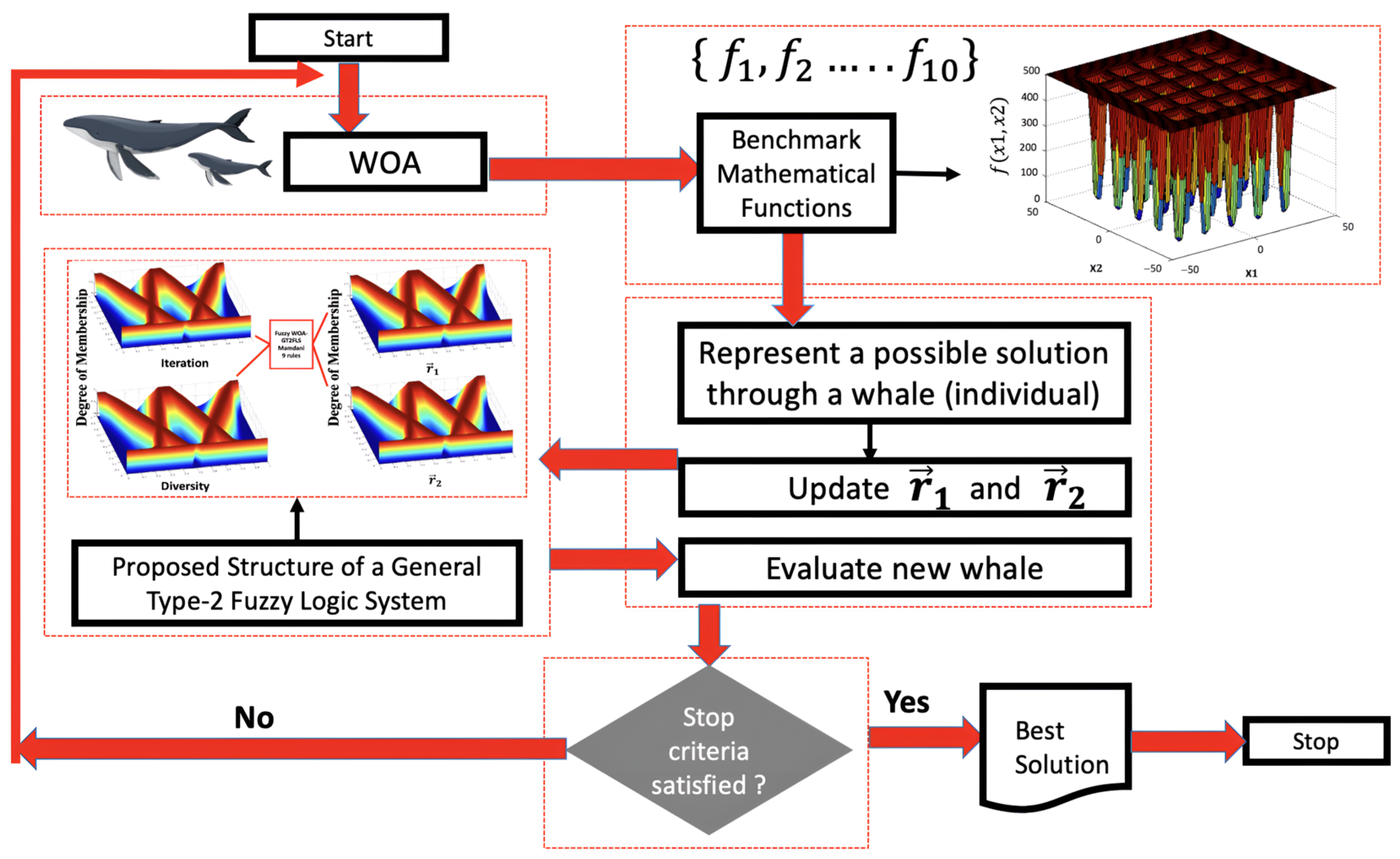


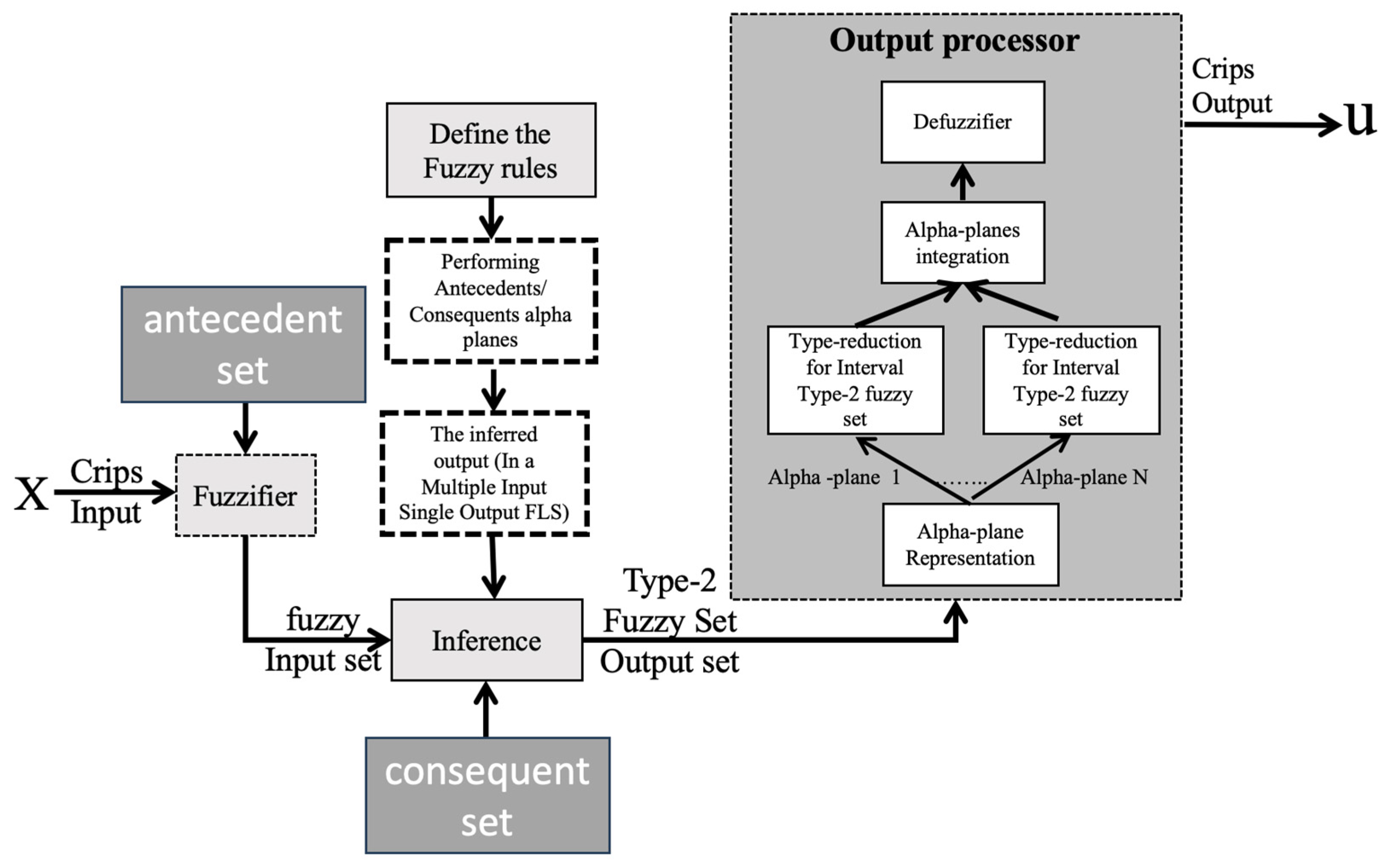
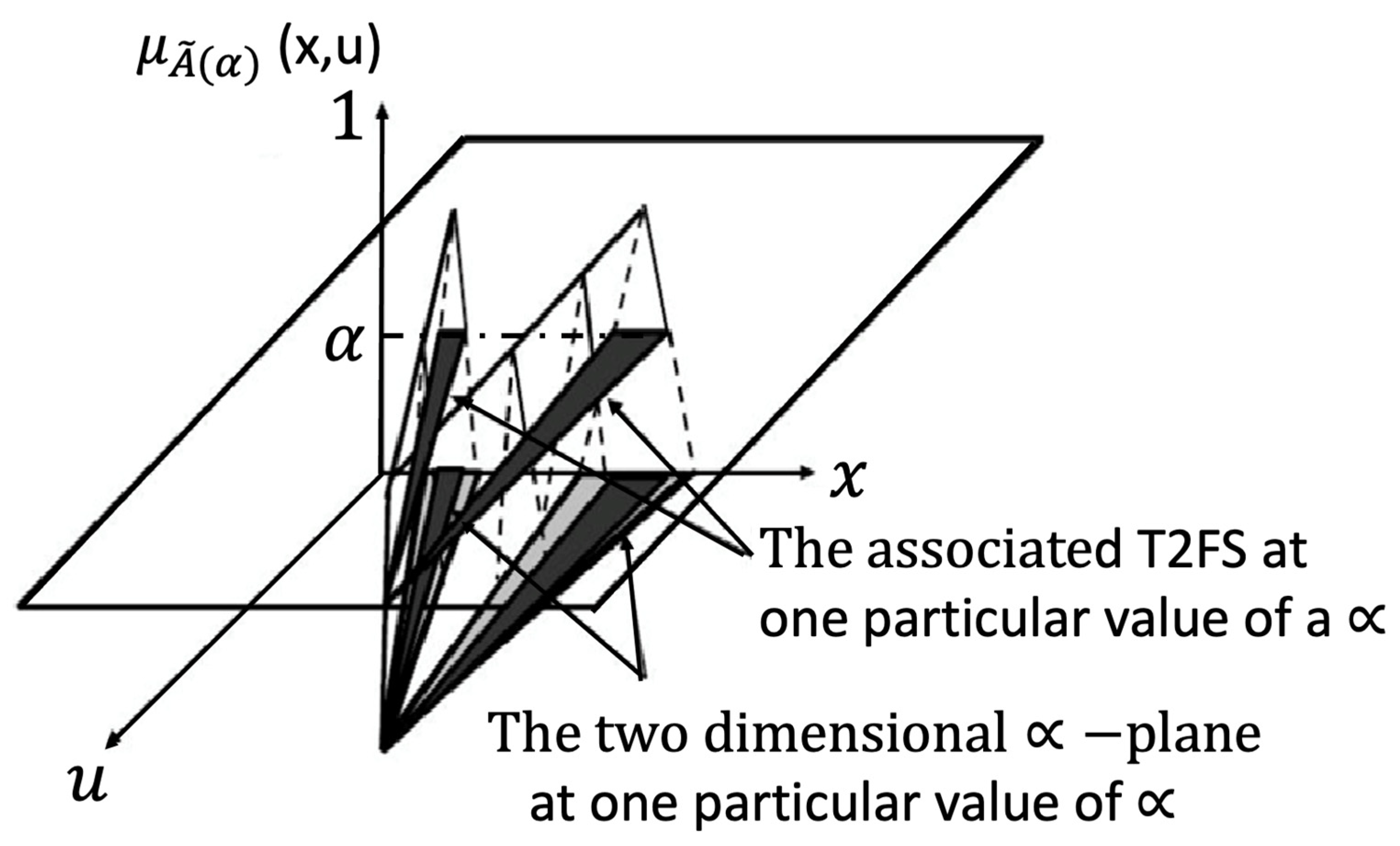

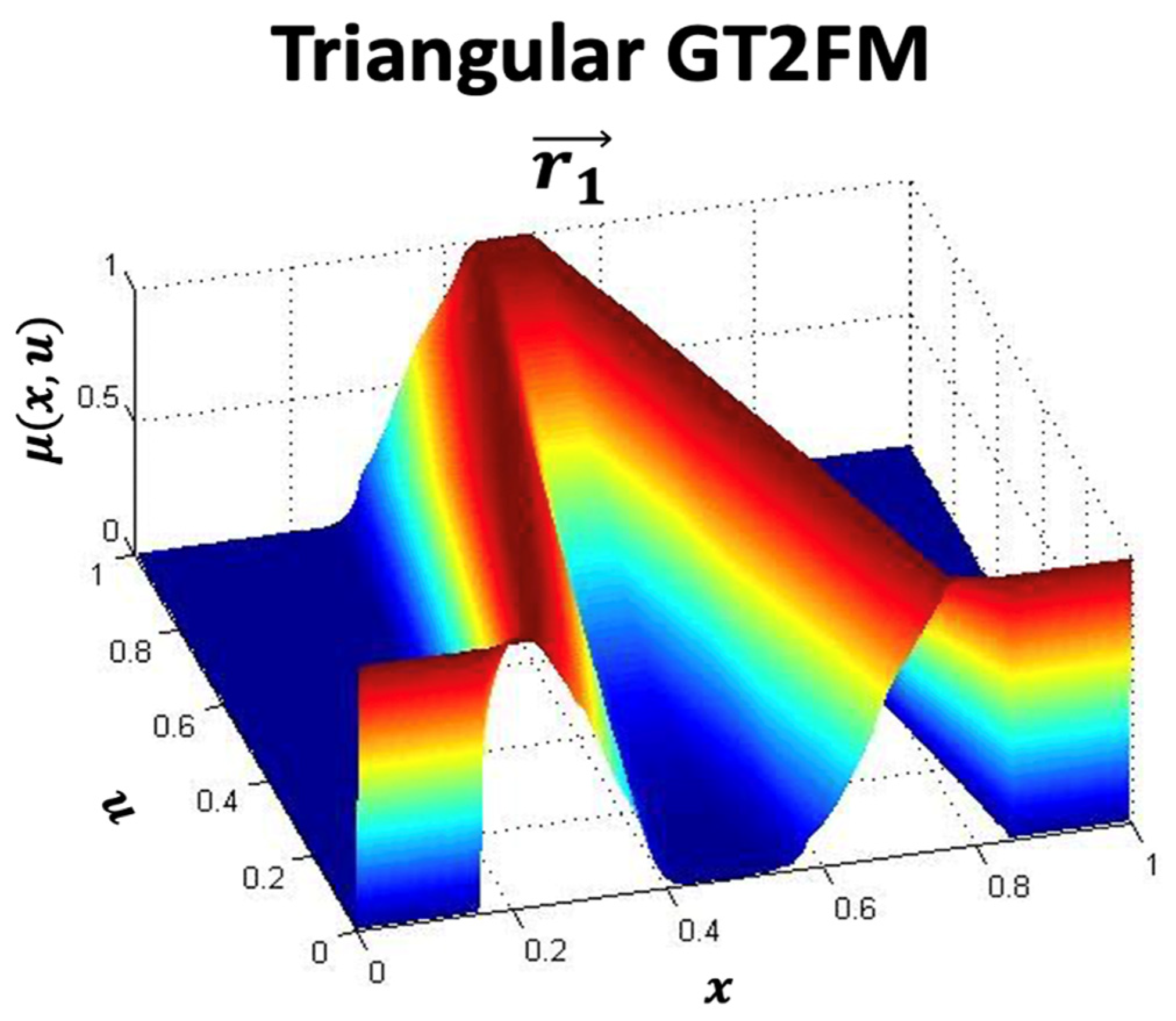



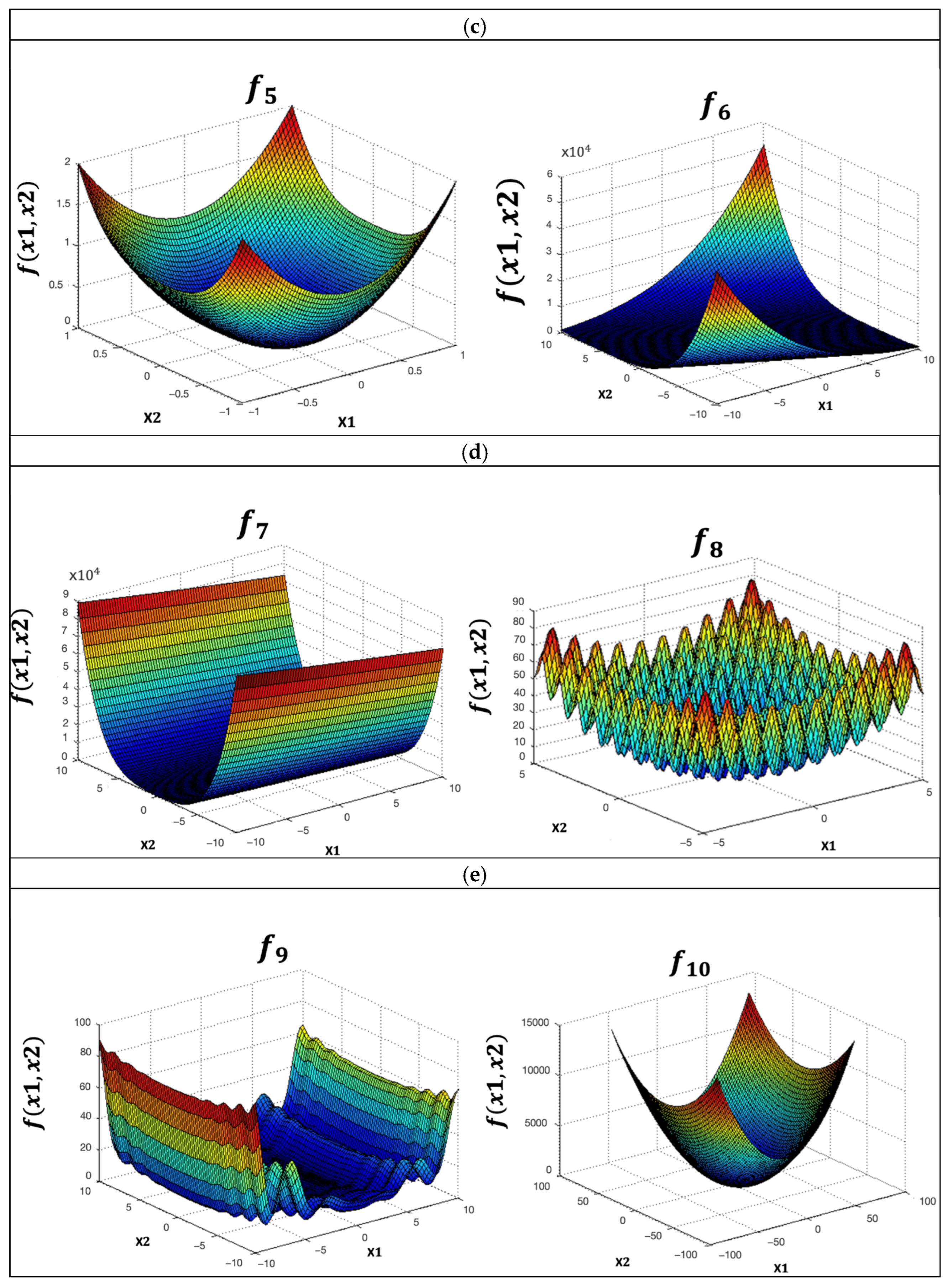
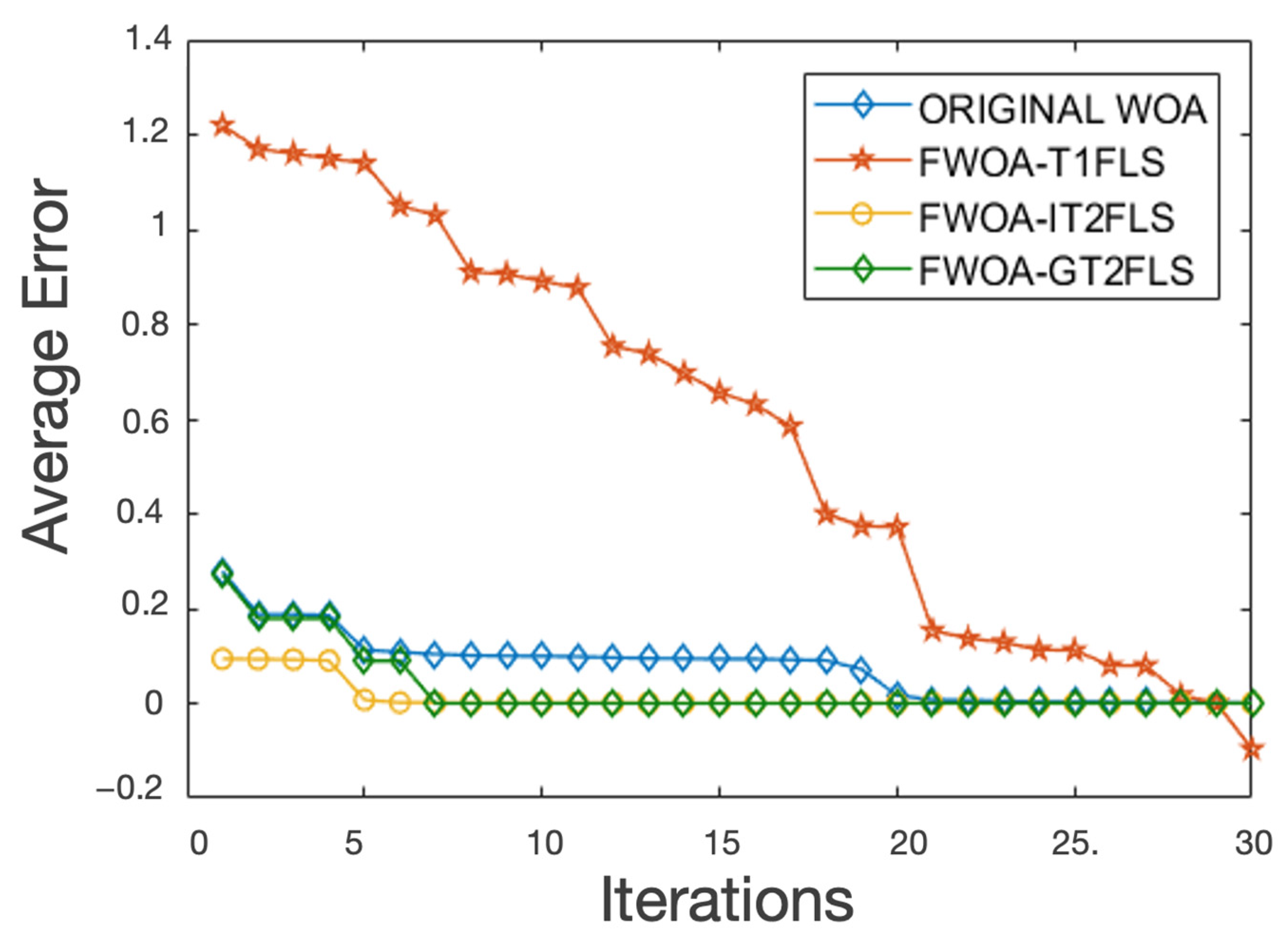
| Whale Optimization |
| Population initialization Xi (i = 1,2,……,n) Compute the fitness of the search agents X* = best agent while (t < maximum number of iterations) for each search agent update: a, A, C, l, and p if1 (p < 0.5) if2 () Update position of current agent by Equation (1) else if2 () Select a random search agent () Update position of current agent by Equation (6) end if2 else if1 (p ) Update position by Equation (5) end if1 end for Check if an agent goes outside the search space and correct it Compute fitness of each agent Update X* if there is a better solution t = t + 1 end while return X* |
| Name | Search Domain | f min | Equation | |
|---|---|---|---|---|
| F1 | Sphere | 0 | ||
| F2 | Griewangk | 0 | ||
| F3 | Rastringin | 0 | ||
| F4 | Shewefel | −837.9658 | ||
| F5 | Sum of Different Power | 0 | ||
| F6 | Zakharov | 0 | ||
| F7 | Dixon and Price | 0 | ||
| F8 | Levy | 0 | , for all i = 1, …, n | |
| F9 | Sum Squares | 0 | ||
| F10 | Rotated Hyper-Ellipsoid | 0 |
| Parameters | Methods | |||
|---|---|---|---|---|
| Original WOA Random | FWOA-T1FLS | FWOA-IT12FLS | FWOA-GT2FLS | |
| Experiments | 30 | 30 | 30 | 30 |
| Iterations | 1000 | 1000 | 1000 | 1000 |
| Dimensions | 10, 20, 30, 50, 100, and 500 | 10, 20, 30, 50, 100, and 500 | 10, 20, 30, 50, 100, and 500 | 10, 20, 30, 50, 100, and 500 |
| Random [0,1] | Dynamic [0,1] | Dynamic [0,1] | Dynamic [0,1] | |
| Random [0,1] | Dynamic [0,1] | Dynamic [0,1] | Dynamic [0,1] | |
| Methods | ||||
|---|---|---|---|---|
| Original WOA Random | FWOA-T1FLS | FWOA-IT12FLS | FWOA-GT2FLS | |
| F1 | 3.93 × 10−94 | 3.06 × 101 | 6.25 × 10−84 | 3.17 × 10−81 |
| F2 | 2.14 × 10−2 | 1.20 × 102 | 1.20 × 102 | 1.20 × 102 |
| F3 | 3.79 × 10−15 | 7.89 × 101 | 2.15 × 101 | 1.89 × 10−15 |
| F4 | 2.23 × 103 | 6.93 × 103 | 6.93 × 103 | 6.93 × 103 |
| F5 | 2.99 × 10−126 | 3.33 × 10−2 | 3.33 × 10−2 | 7.38 × 10−250 |
| F6 | 5.22 × 102 | 4.99 × 10−2 | 3.97 × 10−1 | 3.06 × 10−1 |
| F7 | 6.67 × 10−1 | 2.71 × 105 | 2.28 × 1014 | 1.26 × 10−2 |
| F8 | 9.08 × 10−1 | 1.25 × 101 | 6.20 × 10−1 | 1.25 × 101 |
| F9 | 1.87 × 10−94 | 1.33 × 103 | 3.76 × 10−76 | 1.16 × 10−1 |
| F10 | 2.35 × 10−90 | 7.26 × 104 | 9.02 × 10−76 | 1.01 × 101 |
| Methods | ||||
|---|---|---|---|---|
| Original WOA Random | FWOA-T1FLS | FWOA-IT12FLS | FWOA-GT2FLS | |
| F1 | 3.77 × 10−131 | 1.75 × 101 | 1.22 × 10−103 | 5.26 × 10−104 |
| F2 | 1.16 × 10−2 | 6.62 × 101 | 1.61 × 10−2 | 1.60 × 10−2 |
| F3 | 3.79 × 10−15 | 6.88 × 101 | 3.43 × 103 | 3.43 × 10−1 |
| F4 | 1.95 × 103 | 6.90 × 103 | 6.21 × 103 | 6.90 × 103 |
| F5 | 2.22 × 10−177 | 3.33 × 10−2 | 1.62 × 10−99 | 1.62 × 10−99 |
| F6 | 5.11 × 102 | 4.87 × 102 | 3.88 × 10−1 | 3.29 × 10−1 |
| F7 | 6.67 × 10−1 | 5.79 × 104 | 3.63 × 1014 | 1.40 × 10−2 |
| F8 | 4.16 × 10−1 | 1.21 × 101 | 5.76 × 10−1 | 1.21 × 101 |
| F9 | 4.16 × 10−127 | 1.56 × 10−3 | 1.96 × 10−96 | 4.03 × 10−105 |
| F10 | 5.62 × 10−128 | 5.08 × 104 | 1.26 × 10−57 | 4.19 × 10−97 |
| Methods | ||||
|---|---|---|---|---|
| Original WOA Random | FWOA-T1FLS | FWOA-IT12FLS | FWOA-GT2FLS | |
| F1 | 9.04 × 10−144 | 1.66 × 101 | 5.61 × 10−111 | 1.83 × 10−108 |
| F2 | 4.22 × 10−3 | 6.92 × 101 | 0.00 × 100 | 6.92 × 101 |
| F3 | 1.89 × 10−15 | 5.50 × 10−1 | 7.59 × 100 | 5.50 × 101 |
| F4 | 1.30 × 103 | 6.00 × 103 | 3.79 × 104 | 5.74 × 103 |
| F5 | 2.32 × 10−144 | 4.50 × 10−144 | 4.50 × 10−144 | 4.50 × 10−219 |
| F6 | 4.59 × 102 | 4.59 × 102 | 1.24 × 10−1 | 3.73 × 10−1 |
| F7 | 6.67 × 10−1 | 6.65 × 104 | 8.01 × 105 | 1.31 × 10−2 |
| F8 | 2.06 × 10−1 | 3.64 × 100 | 4.32 × 10−1 | 3.64 × 100 |
| F9 | 2.79 × 10−151 | 9.40 × 102 | 3.34 × 10−108 | 6.65 × 10−103 |
| F10 | 3.46 × 10−147 | 3.79 × 104 | 7.51 × 10−66 | 4.60 × 10−151 |
| Methods | ||||
|---|---|---|---|---|
| Original WOA Random | FWOA-T1FLS | FWOA-IT12FLS | FWOA-GT2FLS | |
| F1 | 7.03 × 10−175 | 1.05 × 101 | 8.36 × 10−114 | 6.82 × 10−112 |
| F2 | 1.16 × 10−3 | 6.32 × 101 | 3.70 × 10−18 | 0.00 × 100 |
| F3 | 0.00 × 100 | 3.66 × 101 | 3.79 × 10−15 | 3.79 × 10−15 |
| F4 | 1.09 × 103 | 6.37 × 103 | 5.30 × 103 | 1.06 × 103 |
| F5 | 7.38 × 10−250 | 3.01 × 103 | 7.38 × 10−250 | 7.33 × 10−250 |
| F6 | 4.69 × 102 | 4.67 × 102 | 4.35 × 10−1 | 1.71 × 100 |
| F7 | 6.67 × 10−1 | 8.58 × 104 | 2.28 × 1014 | 1.30 × 10−2 |
| F8 | 7.84 × 10−2 | 6.00 × 10−1 | 5.81 × 10−1 | 6.00 × 10−1 |
| F9 | 3.26 × 10−173 | 3.83 × 102 | 4.88 × 10−59 | 6.25 × 10−159 |
| F10 | 2.80 × 10−167 | 3.32 × 104 | 2.80 × 10−59 | 2.57 × 10−163 |
| Methods | ||||
|---|---|---|---|---|
| Original WOA Random | FWOA-T1FLS | FWOA-IT12FLS | FWOA-GT2FLS | |
| F1 | 1.88 × 10−193 | 4.37 × 100 | 6.99 × 10−116 | 1.83 × 10−193 |
| F2 | 2.94 × 10−3 | 1.81 × 101 | 3.73 × 10−18 | 3.70 × 10−18 |
| F3 | 0.00 × 100 | 4.63 × 101 | 9.98 × 100 | 0.00 × 100 |
| F4 | 2.02 × 102 | 6.94 × 103 | 4.21 × 103 | 6.49 × 103 |
| F5 | 9.71 × 10−289 | 6.49 × 10−241 | 5.75 × 10−174 | 5.75 × 10−174 |
| F6 | 4.13 × 102 | 4.62 × 102 | 1.29 × 100 | 1.61 × 100 |
| F7 | 6.67 × 10−1 | 3.56 × 104 | 1.22 × 10−2 | 1.20 × 10−2 |
| F8 | 1.85 × 10−1 | 1.16 × 10−1 | 4.38 × 10−1 | 1.12 × 10−1 |
| F9 | 4.45 × 10−194 | 3.30 × 102 | 2.14 × 10−109 | 2.91 × 10110 |
| F10 | 3.99 × 10−188 | 9.45 × 103 | 6.83 × 10−108 | 1.81 × 10−179 |
| Methods | ||||
|---|---|---|---|---|
| Original WOA Random | FWOA-T1FLS | FWOA-IT12FLS | FWOA-GT2FLS | |
| F1 | 4.16 × 10−222 | 6.76 × 10−191 | 6.05 × 100 | 6.76 × 10−191 |
| F2 | 0.00 × 100 | 6.05 × 100 | 6.55 × 10−3 | 6.54 × 10−3 |
| F3 | 3.79 × 10−15 | 3.76 × 101 | 4.42 × 101 | 0.00 × 100 |
| F4 | 1.70 × 102 | 4.56 × 103 | 3.47 × 103 | 3.47 × 103 |
| F5 | 0.00 × 100 | 0.00 × 100 | 1.32 × 10−234 | 2.38 × 10−251 |
| F6 | 2.56 × 102 | 2.99 × 102 | 2.99 × 102 | 2.99 × 102 |
| F7 | 6.45 × 10−1 | 2.20 × 101 | 2.20 × 101 | 6.43 × 10−1 |
| F8 | 3.29 × 10−2 | 1.32 × 10−2 | 1.32 × 10−2 | 3.29 × 10−2 |
| F9 | 2.54 × 10−222 | 1.03 × 102 | 1.03 × 102 | 1.03 × 102 |
| F10 | 1.70 × 10−220 | 7.16 × 103 | 4.10 × 10−98 | 2.32 × 10−107 |
| Methods | ||||
|---|---|---|---|---|
| FWOA-GT2FLS | WOA Random | Z-Value | Evidence | |
| F1 | 3.17 × 10−81 | 3.93 × 10−94 | 1.505 | NS |
| F2 | 1.20 × 102 | 2.14 × 10−2 | 5.007 | NS |
| F3 | 1.89 × 10−15 | 3.79 × 10−15 | −0.584 | NS |
| F4 | 6.93 × 103 | 2.23 × 103 | 1.346 | NS |
| F5 | 7.38 × 10−250 | 2.99 × 10−126 | 1.065 | NS |
| F6 | 3.06 × 10−1 | 5.22 × 102 | −9.776 | S |
| F7 | 1.26 × 10−2 | 6.67 × 10−1 | −79.279 | S |
| F8 | 1.25 × 101 | 9.08 × 10−1 | 4.175 | NS |
| F9 | 1.16 × 10−1 | 1.87 × 10−94 | 7.042 | NS |
| F10 | 1.01 × 101 | 2.35 × 10−90 | 5.857 | NS |
| Methods | ||||||||
|---|---|---|---|---|---|---|---|---|
| WOA Random | Fuzzy WOA-GT2FLS | Fuzzy WOA-IT2FLS [44] | BCO-IT2FLS [43] | |||||
| Best | Worst | Best | Worst | Best | Worst | Best | Worst | |
| F1 | 2.57 × 10−198 | 1.35 × 10−173 | 1.48 × 10−128 | 1.80 × 10−110 | 1.74 × 10−59 | 2.94 × 10−60 | 7.74 × 10−8 | 6.94 × 10−7 |
| F2 | 0.00 × 100 | 3.49x 10−2 | 0.00 × 100 | 0.00 × 100 | 3.73 × 10−8 | 4.02 × 10−8 | 8.40 × 10−5 | 3.26 × 10−2 |
| F3 | 0.00 × 100 | 0.00 × 100 | 0.00 × 100 | 1.14 × 10−13 | 4.78 × 10−9 | 8.90 × 10−9 | 7.52 × 100 | 1.51 × 101 |
| F4 | 8.73 × 10−3 | 4.70 × 103 | 8.73 × 10−3 | 4.70 × 103 | 3.03 × 102 | 3.03 × 102 | 1.01 × 103 | 2.47 × 103 |
| F5 | 1.14 × 10−292 | 2.21 × 10−248 | 1.32 × 10−218 | 2.21 × 10−248 | 1.77 × 10−86 | 7.93 × 10−41 | 1.87 × 10−10 | 1.08 × 10−6 |
| F6 | 1.68 × 10−1 | 6.60 × 102 | 5.00 × 100 | 8.89 × 100 | 4.99 × 100 | 8.53 × 100 | 5.46 × 102 | 7.20 × 102 |
| F7 | 6.67 × 10−1 | 6.67 × 10−1 | 5.00 × 100 | 3.18 × 10−1 | 4.14 × 10−4 | 3.18 × 10−1 | 1.76 × 100 | 9.06 × 100 |
| F8 | 1.97 × 10−3 | 2.79 × 10−1 | 1.50 × 10−1 | 2.12 × 100 | 9.63 × 10−2 | 1.22 × 100 | 6.37 × 10−7 | 1.04 × 10−5 |
| F9 | 1.28 × 10−186 | 6.62 × 10−172 | 8.25 × 100 | 9.53 × 100 | 1.70 × 10−57 | 7.68 × 10−58 | 5.10 × 106 | 1.29 × 10−4 |
| F10 | 7.80 × 10−158 | 8.38 × 10−166 | 4.74 × 101 | 4.20 × 101 | 6.29 × 10−59 | 5.96 × 10−58 | 1.35 × 10−4 | 2.44 × 10−3 |
| Methods | ||||
|---|---|---|---|---|
| WOA Random | FWOA-GT2FLS | FWOA-IT2FLS [44] | FBCO-IT2FLS [43] | |
| F1 | 0.00 × 100 | 3.29 × 10−111 | 2.63 × 10−59 | 1.74 × 10−7 |
| F2 | 6.38 × 10−3 | 0.00 × 100 | 1.36 × 10−8 | 6.12 × 10−3 |
| F3 | 0.00 × 100 | 0.00 × 100 | 8.14 × 10−10 | 1.98 × 100 |
| F4 | 1.52 × 103 | 1.52 × 109 | 3.37 × 10−12 | 3.59 × 102 |
| F5 | 0.00 × 100 | 0.00 × 100 | 2.67 × 10−43 | 2.46 × 10−7 |
| F6 | 1.10 × 102 | 4.78 × 109 | 1.29 × 100 | 3.89 × 101 |
| F7 | 9.25 × 10−5 | 5.77 × 10−2 | 1.20 × 10−2 | 1.76 × 100 |
| F8 | 6.98 × 10−2 | 3.89 × 10−1 | 4.38 × 10−1 | 1.91 × 10−6 |
| F9 | 0.00 × 100 | 5.37 × 109 | 7.47 × 10−59 | 2.50 × 10−5 |
| F10 | 0.00 × 100 | 2.53 × 109 | 2.01 × 10−60 | 6.83 × 10−4 |
Disclaimer/Publisher’s Note: The statements, opinions and data contained in all publications are solely those of the individual author(s) and contributor(s) and not of MDPI and/or the editor(s). MDPI and/or the editor(s) disclaim responsibility for any injury to people or property resulting from any ideas, methods, instructions or products referred to in the content. |
© 2024 by the authors. Licensee MDPI, Basel, Switzerland. This article is an open access article distributed under the terms and conditions of the Creative Commons Attribution (CC BY) license (https://creativecommons.org/licenses/by/4.0/).
Share and Cite
Amador-Angulo, L.; Castillo, O.; Melin, P.; Geem, Z.W. Generalized Type-2 Fuzzy Approach for Parameter Adaptation in the Whale Optimization Algorithm. Mathematics 2024, 12, 4031. https://doi.org/10.3390/math12244031
Amador-Angulo L, Castillo O, Melin P, Geem ZW. Generalized Type-2 Fuzzy Approach for Parameter Adaptation in the Whale Optimization Algorithm. Mathematics. 2024; 12(24):4031. https://doi.org/10.3390/math12244031
Chicago/Turabian StyleAmador-Angulo, Leticia, Oscar Castillo, Patricia Melin, and Zong Woo Geem. 2024. "Generalized Type-2 Fuzzy Approach for Parameter Adaptation in the Whale Optimization Algorithm" Mathematics 12, no. 24: 4031. https://doi.org/10.3390/math12244031
APA StyleAmador-Angulo, L., Castillo, O., Melin, P., & Geem, Z. W. (2024). Generalized Type-2 Fuzzy Approach for Parameter Adaptation in the Whale Optimization Algorithm. Mathematics, 12(24), 4031. https://doi.org/10.3390/math12244031











